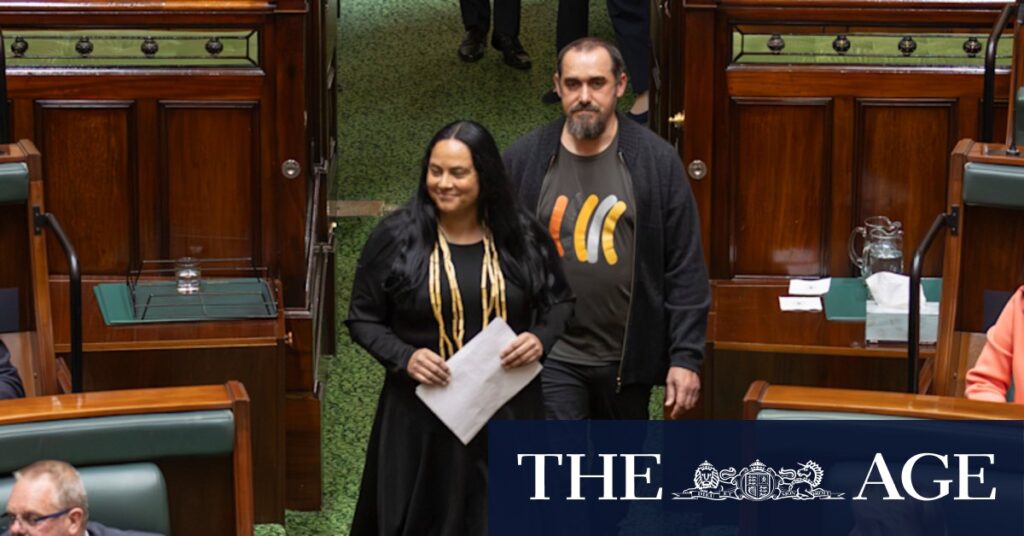
Sweet smoke of green gum leaves wreathed the bluestone steps of Victoria’s Parliament House as Uncle Andrew Gardiner, cloaked in possum skin from beard to toe, offered a poignant perspective. Parliament House, he noted, was built in 1856. His Wurundjeri Woi-Wurrung people had shared stories around campfires for thousands of years before that, and the site on which Parliament House was constructed “is also our traditional ceremony ground.”
“We hosted members and delegations from the other [peoples of the] Kulin nation,” he said. “We had discussions, made agreements, much the same as what happens in this building today.” Looking directly at Premier Jacinta Allan, Uncle Andrew, representing the First Peoples’ Assembly of Victoria, declared, “We entrust you do the right thing by us.” This was a reference to the final steps towards a statewide treaty—the first of its kind in Australia between a parliament and Aboriginal people.
A Historic Step Towards Reconciliation
The bill legislating the Victorian treaty received its second reading on Tuesday. The smoking ceremony on the parliamentary steps was designed as a Welcome to Country for those debating the issue and for those coming to pay witness. The co-chairs of the First Peoples’ Assembly, Ngarra Murray and Rueben Berg, addressed the Legislative Assembly as numerous First Nations elders took their seats in the gallery above the state’s members of parliament.
The elders, representing a multitude of Aboriginal nations including the Gunnai, Yorta Yorta, Mutti Mutti, and many others, came from across the state. Their presence underscored the broad support and significance of this legislative effort.
Voices of the First Peoples
“The time for paternalistic government making decisions on behalf of our people ends with this treaty,” Murray told the parliament. “No longer will policies be made about us, without us. Our people will no longer tolerate the political football that politicians kick around looking to further their own selfish interests. We are sovereign peoples with the oldest system of governance on earth.”
Murray and Berg spoke of the treaty process as gellung warl—the “tip of the spear” in the Gunaikurnai language—and the name of a new democratically elected body. “A spear that is crafted with a task in mind, created with care,” Murray explained. Berg elaborated, saying that spears were made from wood and straightened by hand, the point reinforced by fire and bound in fibre, sinew, and resin.
Historical Context and Future Implications
The announcement comes as Australia grapples with its colonial past and the ongoing impacts on its Indigenous populations. For over 200 years, Berg noted, “we’ve had successive governments saying they know best about our business. Countless bodies, commissions, and policies [have been] set up without the leadership of First Peoples. Even with governments with good intentions, it just does not work.”
“Today we can agree to move forward by discontinuing the centuries of ineffective and harmful policies,” Berg asserted.
This development follows a broader national conversation about Indigenous rights, highlighted by the recent debates over the Voice to Parliament—a proposed advisory body that would give Aboriginal and Torres Strait Islander peoples a greater say in policies affecting their communities.
Expert Opinions and Analysis
Experts in Indigenous law and policy have hailed the Victorian treaty bill as a landmark step. Dr. Marcia Langton, a prominent academic and advocate for Indigenous rights, emphasized the importance of formal treaties in recognizing the sovereignty and self-determination of First Peoples. “This is not just a symbolic gesture; it’s about real power-sharing and acknowledging the injustices of the past,” she said.
Comparisons have been drawn to similar treaties in New Zealand and Canada, where formal agreements have led to significant advancements in Indigenous rights and governance. However, experts caution that the success of such treaties depends on their implementation and the genuine commitment of all parties involved.
Looking Ahead
The move represents a significant shift in the relationship between the Victorian government and its Indigenous communities. As the bill progresses, it will require careful negotiation and collaboration to ensure that the treaty delivers tangible benefits and respects the sovereignty of the First Peoples.
Meanwhile, the broader implications for Australia are profound. If successful, the Victorian treaty could serve as a model for other states and territories, potentially paving the way for a national treaty framework.
As the legislative process continues, the eyes of the nation will be on Victoria, watching closely as it navigates this historic path towards reconciliation and justice for its First Peoples.







